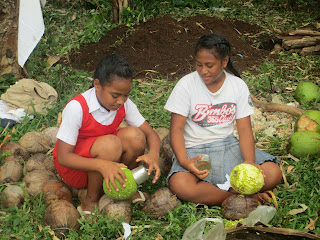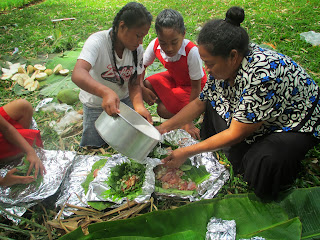With the Class 6 exam in our
rearview mirror, the teachers and I have had some opportunities to be a little
more creative with what we do with our time at school. Last week, Paea and I
decided to spend the first two days of school building an umu (underground oven) and making the traditional Tongan meal of lu with our Class 6 and 5 students. Lu, for those of you who do not
remember from previous posts, is named for the lu leaves that constitute the most important aspect of the meal.
The leaves are spread out, and meat, such as fish, chicken, beef, lamb, and
canned beef/fish, onions, salt, and juice from the coconut meat are placed on
top of the leaves. Other ingredients, especially other vegetables, can be added
to this recipe but lu, onions, meat,
salt, and coconut milk are the meal’s true staples. The food is encased in the lu leaves, and then wrapped
traditionally in banana leaves or more recently aluminum foil, and placed inside
the oven for about two hours to cook.
The first day was all about
preparation. The boys hopped over the fence in the back of the school compound
to scrounge for the materials we needed, while the girls were content to laugh
and watch how hard the boys were working. The first task was to find firewood.
The 10 and 11 year old boys, who are so adept in the bush with a machete as
they have been working in the bush since they were old enough to walk, made
quick work of the nearby trees and threw the wood we needed over the fence onto
the school. They then looked for the rocks that would be burned in the umu to bake the food.
After this the boys got a
little creative. Apparently, the church minister of one of the villages taught
the kids how to make a chicken trap. With surprising skill and dexterity, the
boys built a pressure sensitive trap that would hopefully snare a chicken by
the leg with a rope and leave it dangling upside down. I asked Paea if this was
ok, as even though the chickens are in the bush and are not fenced in, they are
not wild animals and someone does own them. He looked at me, shrugged, and said
in a voice that left much doubt to his statement’s veracity that, “People don’t
really care about a chicken or two. They only get mad if you steal a pig.”
Neither of us really bought that, but a funny conversation did ensue between
Paea and Soeli, the leader of the students designing the trap.
(All in Tongan)
Paea: What are you doing?
Soeli: Catching chickens
Paea: What chickens?
Soeli: We’re stealing them!
Paea: For who?
Soeli: For Soni!!!! (That’s
me).
Somewhat luckily we did not
catch any chickens, so no one was mad at me for apparently being the ringleader
of a bunch of chicken thieves.
Once the kids were done
collecting the rocks and the wood, climbing up trees to retrieve coconuts, and
finished building the traps, they hopped back over the fence. All that was left
for the day was to dig a whole in the ground that would serve as our umu – about 4 feet long, 2 feet wide,
and 4 feet deep – and chop up the wood for the next day.
Tuesday was more fun. The
teachers and the kids brought chicken – legally bought or raised – lu leaves, onions, canned fish, bread
fruit, and kape (a Tongan root crop that
I do not know the English equivalent for). The first step was to prepare the
meat – pluck off the wings, remove the entrails and other organs, and wash off
the blood – before placing the food on top of the lu leaves next to the cut up onions. Several of the boys were in
charge of husking the coconuts, scraping off the meat, and then twisting the meat
to get to the milk of the coconut. A few of the girls and the boys cut the cans
of the fish in half to use the raggedy edges to scrape off the outside of the mei (bread fruit) to prepare for it to
be baked. Our strongest boy, Lili, used a machete to peel the kape – somewhat similarly to how you
peel a potato just on a larger scale – before tossing it into the oven.
Once these steps were finished,
the students with the help of my principal Selu, poured some of the coconut
milk onto the lu, which provides the
food with most of its flavor. The lu
was wrapped around the food, which was then in turn wrapped within tin foil. Finally,
everything was ready to be baked. While all of this was happening, a fire was
raging in our umu, as the wood was
used to heat up the rocks. Once the fire was done, the rocks were shifted
around, and then the lu, mei, and kape are spread over the rocks to bake. After
the food is securely in place, the kids covered the food with a sheet to
protect it and keep it clean, and then poured heaps of dirt on top of the sheet
to trap all of the heat within the oven to cook the food faster.
Two hours later, the food was
ready. Almost too hot to grab out of the umu,
and then way too hot to eat with my fingers due to the absence of silverware,
the students, teachers, and I sat upon banana leaves in a circle for a lu picnic. After the mandatory prayer,
we dug in. While not the best lu I
have ever eaten, the food was surprisingly good and it was a lot of fun to eat
as a school after putting so much labor into the project. I still marvel at how
efficient and skilled these kids are in every aspect of the kai umu (eating food from an underground
oven) – using a machete, preparing meat, starting a fire, retrieving and
husking coconuts, etc – and how different their lives are than how mine was
growing up. It was an absolutely fascinating experience to see them do something
that is such an integral part of their lives, but was never even part of my
consciousness before I arrived in Tonga.
Thank you all for reading. I
took way too many photos over these two days, so I have posted a few of them
below and will upload the rest over the next few posts. Happy Halloween!
Maria (left) and Lose (right) scraping off the outer layer of the breadfruit
Sosefina, Paea, and Soana preparing the lu leaves
My principal Selu helping two of the girls pour the coconut milk onto the food to provide flavoring
Finished! Enjoying our lu picnic
















